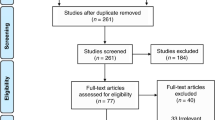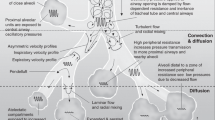Abstract
There are physiological rationale and experimental data that suggest permissive hypercapnia and/or permissive hypoxemia may be well tolerated and result in reduced lung injury. Controlled studies in neonates report potential benefits of both permissive hypercapnia and permissive hypoxemia. The limited randomized controlled trials assessing early short-term postnatal use of permissive hypercapnia demonstrate positive or neutral results. The trials of permissive hypoxemia enrolled infants after the first week of life and also reported positive or neutral results. There is a need for further research testing whether these strategies improve pulmonary outcomes without an increased risk of impaired neurodevelopmental or other adverse effects.
This is a preview of subscription content, access via your institution
Access options
Subscribe to this journal
Receive 12 print issues and online access
$259.00 per year
only $21.58 per issue
Buy this article
- Purchase on Springer Link
- Instant access to full article PDF
Prices may be subject to local taxes which are calculated during checkout


Similar content being viewed by others
References
Slutsky AS . ACCP Consensus Conference. Mechanical Ventilation. Chest 1993; 104: 1833–1859.
Artigas A, Bernard GR, Carlet J, Dreyfuss D, Gattinoni L, Hudson L et al. and the Consensus Committee Conference Report. The American-European Consensus Conference on ARDS, Part 2. Ventilatory, pharmacologic, supportive therapy, study design strategies, and issues related to recovery and remodeling. Am J Respir Crit Care Med 1998; 157: 1332–1347.
Dreyfus D, Saumon G . Role of tidal volume, FRC and end-inspiratory volume in the development of pulmonary edema following mechanical ventilation. Am Rev Respir Dis 1993; 48: 1194–1203.
Peevy KJ, Hernandez LA, Moise AA, Parker JC . Barotrauma and microvascular injury in lungs of nonadult rabbits: effect of ventilation pattern. Crit Care Med 1990; 18: 634.
Parker JC, Hernandez LA, Peevy KJ . Mechanisms of ventilator-induced lung injury. Crit Care Med 1993; 21: 131–143.
Carlton DP, Cummings JJ, Scheerer RG, Paulain FR, Bland RD . Lung overexpansion increases pulmonary microvascular protein permeability in young lambs. J Appl Physiol 1990; 69: 577–583.
Dreyfuss D, Saumon G . Ventilator-induced lung injury lessons from experimental studies. Am J Respir Crit Care Med 1998; 157: 294–323.
Muscedere JG, Mullen JB, Gan K, Slutsky AS . Tidal ventilation at low airway pressures can augment lung injury. Am J Respir Crit Care Med 1994; 149: 1327–1334.
Sandhar BK, Niblett DJ, Argiras EP, Dunnill MS, Sykes MK . Effects of positive end-expiratory pressure on hyaline membrane formation in a rabbit model of the neonatal respiratory distress syndrome. Intens Care Med 1988; 14: 538–546.
Bjorklund LJ, Imgimarsson J, Curstedt T, John J, Robertson B, Werner O et al. Manual ventilation with a few large breaths at birth compromises the therapeutic effect of subsequent surfactant replacement in immature lambs. Pediatr Res 1997; 42: 348–355.
Ingimarsson J, Bjorklund LJ, Curstedt T, Gudmundsson S, Larsson A, Robertson B et al. Incomplete protection by prophylactic surfactant against the adverse effects of large lung inflations at birth in immature lambs. Intensive Care Med 2004; 30: 1446–1453.
Auten RL . Mechanisms of neonatal lung injury In: Polin RA, Fox WW, Abman SH (eds). Fetal and Neonatal Physiology. (3rd ed). Saunders: Philadelphia, PA, 2004, pp 934–941.
Frank L, Sosenko IR . Failure of premature rabbits to increase antioxidant enzymes during hyperoxic exposure: increased susceptibility to pulmonary oxygen toxicity compared with term rabbits. Pediatr Res 1991; 29: 292.
Varsila A, Pesonen E, Andersson S . Early protein oxidation in the neonatal lung is related to development of chronic lung disease. Acta Paediatr 1995; 11: 1296–1299.
Boynton BR, Hammond MD . Pulmonary gas exchange: basic principles and the effects of mechanical ventilation In: Boynton B, Carlo WA, Jobe A (eds). New Therapies for Neonatal Respiratory Failure: A Physiologic Approach. Cambridge University Press: Cambridge, England, 1994, pp 115–129.
Kondo T, Kumagai M, Ohta Y, Bishop B . Ventilatory responses to hypercapnia and hypoxia following chronic hypercapnia in the rate. Respir Physiol 2000; 122: 35–43.
Traverse JH, Korvenranta H, Adams EM, Goldthwait DA, Carlo WA . Impairment of hemodynamics with increasing mean airway pressure during high-frequency oscillatory ventilation. Pediatr Res 1988; 23: 628–631.
Kaiser JR, Gauss CH, Williams DK . The effects of hypercapnia on cerebral autoregulation in ventilated very low birth weight infants. Pediatr Res 2005; 58: 931–935.
Wallin LA, Rosenfeld CR, Laptook AR, Maravilla AM, Strand C, Campbell N et al. Neonatal intracranial hemorrhage: II. Risk factor analysis in an inborn population. Early Hum Dev 1990; 23: 129–137.
Fabres J, Carlo W, Phillips V et al. Both extremes of PaCO2 and the magnitude of fluctuations are associated with severe intraventricular hemorrhage in preterm infants. Pediatrics 2007; 119: 299–305.
Collins MP, Lorenz JM, Jetton JR, Paneth N . Hypocapnia and other ventilation-related risk factors for cerebral palsy in low birth weight infants. Pediatr Res 2001; 50: 712–719.
Thome UH, Carlo WA . Permissive hypercapnia. Semin Neonatol 2002; 7: 409–419.
Sinclair SE, Kregenow DA, Lamm WJ, Starr IR, Chi EY, Hlastala MP . Hypercapnic acidosis is protective in an in vivo model of ventilator-induced lung injury. Am J Respir Crit Care Med 2002; 166: 403–408.
Laffey JG, Tanaka M, Engelberts D, Luo X, Yuan S, Tanswell AK et al. Therapeutic hypercapnia reduces pulmonary and systemic injury following in vivo lung reperfusion. Am J Respir Crit Care Med 2000; 162: 2287–2294.
Laffey JG, Honan D, Hopkins N, Hyvelin JM, Boylan JF, McLoughlin P . Hypercapnic acidosis attenuates endotoxin-induced acute lung injury. Am J Respir Crit Care Med 2004; 169: 46–56.
Vannucci RC, Towfighi J, Heitjan DF, Brucklacher RM . Carbon dioxide protects the perinatal brain from hypoxic-ischemic damage: an experimental study in the immature rat. Pediatrics 1995; 95: 868–874.
Kantores C, Tanswell AK, Kavanagh BP, Jankov RP . Therapeutic hypercapnia limits oxidant stress and protects against pulmonary vascular remodeling in newborn rats chronically exposed to hypoxia. PAS 2005; 57: 80.
Laffey JG, Tanaka M, Engelberts D, Luo X, Yuan S, Tanswell AK et al. Therapeutic hypercapnia reduces pulmonary and systemic injury following in vivo lung reperfusion. Am J Respir Crit Care Med 2000; 162: 2287–2294.
Feihl F, Eckert P, Brimioulle S, Jacobs O, Schaller MD, Melot C et al. Permissive hypercapnia impairs pulmonary gas exchange in the acute respiratory distress syndrome. Am J Respir Crit Care Med 2000; 162: 209–215.
Sinclair SE, Kregenow DA, Starr I, Schimmel C, Lamm WJ, Hlastala MP et al. Therapeutic hypercapnia and ventilation-perfusion matching in acute lung injury: low minute ventilation vs inspired CO2. Chest 2006; 130: 85–92.
Saugstad OD . Oxidative stress in the newborn – a 30-year perspective. Biol Neonate 2005; 88: 228–236.
Petrucci N, Iacovelli W . Ventilation with lower tidal volumes versus traditional tidal volumes in adults for acute lung injury and acute respiratory distress syndrome. Cochrane Database of Systematic Reviews 2004. Issue 2. Art. No.: CD003844. DOI: 10.1002/14651858.CD003844.pub2.
Kraybill EN, Runyun DK, Bose CL, Khan JH . Risk factors for chronic lung disease in infants with birth weights of 751 to 1000 grams. J Pediatr 1989; 115: 115–120.
Garland JS, Buck RK, Allred EN, Leviton A . Hypocarbia before surfactant therapy appears to increase bronchopulmonary dysplasia risk in infants with respiratory distress syndrome. Arch Pediatr Adolesc Med 1995; 149: 617–622.
Dudell GG, CDH Study Group. Are permissive strategies now standard of care for neonates with congenital diaphragmatic hernia (CDH)? E-PAS 2006; 59: 453.
Bogolan P, Casaccia G, Crescenzi F, Nahom A, Trucchi A, Giorlandino C . Impact of a current treatment protocol on outcome of high-risk congenital diaphragmatic hernia. J Pediatr Surg 2004; 39: 313–318.
Mariani G, Cifuentes J, Carlo WA . Randomized trial of permissive hypercapnia in preterm infants. Pediatrics 1999; 104: 1082–1088.
Carlo WA, Stark AR, Wright LL, Tyson JE, Papile LA, Shankaran S et al. Minimal ventilation to prevent bronchopulmonary dysplasia in extremely-low-birth-weight infants. J Pediatr 2002; 141 (3): 370–374.
Thome UH, Carroll W, Wu TJ, Johnson RB, Roane C, Young D et al. Outcome of extremely preterm infants randomized at birth to different PaCO(2) targets during the first seven days of life. Biol Neonate 2006; 90: 218–225.
Sovik S, Lossius K . Development of ventilatory response to transient hypercapnia and hypercapnic hypoxia in term neonates. Pediatr Res 2004; 55: 302–309.
Vijayakumar E, Ward GJ, Bullock CE, Patterson ML . Pulse oximetry in infants of <1500 grams birth weight on supplemental oxygen: a national survey. J Perinatol 1997; 17: 341–345.
Ellsbury DL, Acarregui MJ, McGuinness GA, Klein JM . Variability in the use of supplemental oxygen for bronchopulmonary dysplasia. J Pediatr 2002; 140: 247–249.
Tin W, Milligan DWA, Pennefather P, Hey E . Pulse oximetry, severe retinopathy, and outcome at one year in babies of less than 28 weeks gestation. Arch Dis Child Fetal Neonatal Ed 2001; 84: F106–F110.
Sun SC . Relation of target SpO2 levels and clinical outcome in ELBW infants on supplemental oxygen. Pediatr Res 2002; 51: 350A (abstract).
Anonymous . Supplemental Therapeutic Oxygen for Prethreshold Retinopathy of Prematurity (STOP-ROP), a randomized, controlled trial I: primary outcomes. Pediatrics 2000; 105: 295–310.
Askie LM, Henderson-Smart DJ, Irwig L, Simpson JM . Oxygen-saturation targets and outcomes in extremely preterm infants. N Engl J Med 2003; 349: 959–967.
Cole CH, Wright KW, Tarnow-Mordi W, Phelps DL . Resolving our uncertainty about oxygen therapy. Pediatrics 2006; 112: 1415–1419.
Walsh MC, Yao Q, Gettner P, Hale E, Collins M, Hensman A et al. Impact of a physiologic definition on bronchopulmonary dysplasia rates. Pediatrics 2004; 114: 1305–1311.
Carlo WA . Gentle ventilation and permissive hypercapnia in neonates. Persp Neonatol 2000; 1: 4–16.
Miller D, Carlo WA . Safety and Effectiveness of Permissive Hypercapnia in the Preterm Infant. Current Opin Pediatr 2007, in press.
Kamper J, Feilberg Jorgensen N, Jonsbo F, Pedersen-Bjergaard L, Pryds O . The Danish national study in infants with extremely low gestational age and birthweight (the ETFOL study): respiratory morbidity and outcome. Acta Paediatr 2004; 93 (2): 225–232.
Tin W . Optimal oxygen saturation for preterm babies. Biol Neonate 2004; 85: 319–325.
Author information
Authors and Affiliations
Corresponding author
Rights and permissions
About this article
Cite this article
Carlo, W. Permissive hypercapnia and permissive hypoxemia in neonates. J Perinatol 27 (Suppl 1), S64–S70 (2007). https://doi.org/10.1038/sj.jp.7211715
Published:
Issue Date:
DOI: https://doi.org/10.1038/sj.jp.7211715



